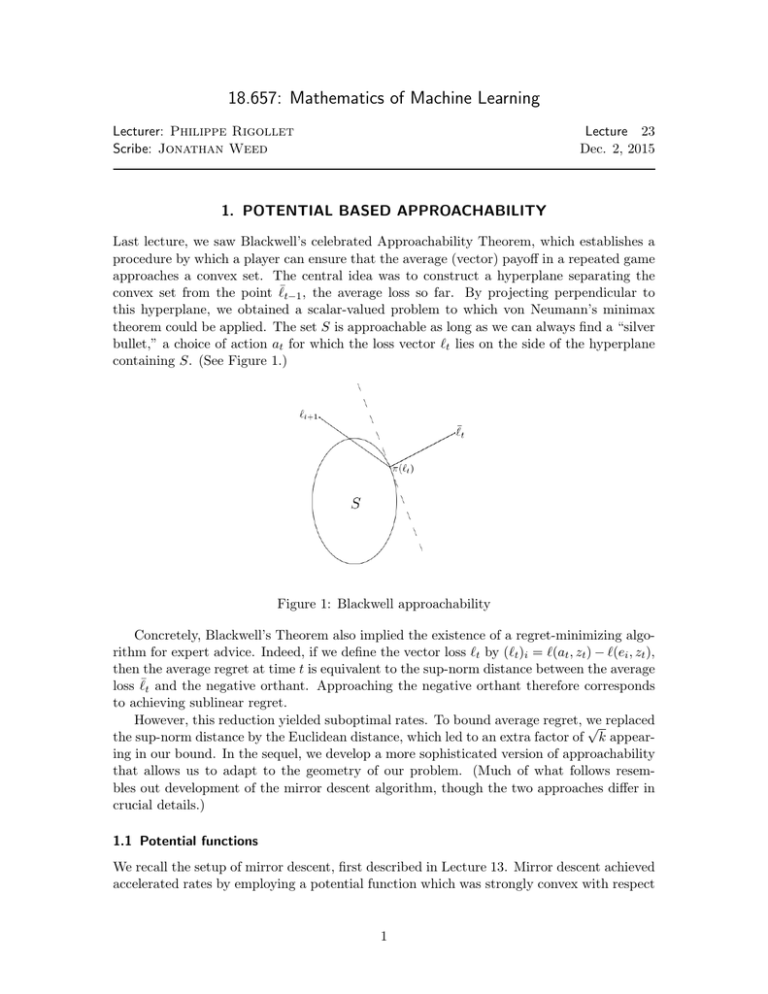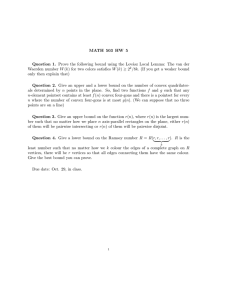18.657: Mathematics of Machine Learning 1. POTENTIAL BASED APPROACHABILITY
advertisement

18.657: Mathematics of Machine Learning
Lecturer: Philippe Rigollet
Scribe: Jonathan Weed
Lecture 23
Dec. 2, 2015
1. POTENTIAL BASED APPROACHABILITY
Last lecture, we saw Blackwell’s celebrated Approachability Theorem, which establishes a
procedure by which a player can ensure that the average (vector) payoff in a repeated game
approaches a convex set. The central idea was to construct a hyperplane separating the
convex set from the point `¯t−1 , the average loss so far. By projecting perpendicular to
this hyperplane, we obtained a scalar-valued problem to which von Neumann’s minimax
theorem could be applied. The set S is approachable as long as we can always find a “silver
bullet,” a choice of action at for which the loss vector `t lies on the side of the hyperplane
containing S. (See Figure 1.)
Figure 1: Blackwell approachability
Concretely, Blackwell’s Theorem also implied the existence of a regret-minimizing algorithm for expert advice. Indeed, if we define the vector loss `t by (`t )i = `(at , zt ) − `(ei , zt ),
then the average regret at time t is equivalent to the sup-norm distance between the average
loss `¯t and the negative orthant. Approaching the negative orthant therefore corresponds
to achieving sublinear regret.
However, this reduction yielded suboptimal rates. To bound average regret, w
√e replaced
the sup-norm distance by the Euclidean distance, which led to an extra factor of k appearing in our bound. In the sequel, we develop a more sophisticated version of approachability
that allows us to adapt to the geometry of our problem. (Much of what follows resembles out development of the mirror descent algorithm, though the two approaches differ in
crucial details.)
1.1 Potential functions
We recall the setup of mirror descent, first described in Lecture 13. Mirror descent achieved
accelerated rates by employing a potential function which was strongly convex with respect
1
to the given norm. In this case, we seek what is in some sense the opposite: a function
whose gradient does not change too quickly. In particular, we make the following definition.
Definition: A function Φ : IRd → IR is a potential for S ∈ IR if it satisfies the following
properties:
• Φ is convex.
• Φ(x) ≤ 0 for x ∈ S.
• Φ(y) = 0 for y ∈ ∂S.
• Φ(y) − Φ(x) − h∇Φ(x), y − xi ≤ h2 kx − yk2 , where by abuse of notation we use
∇Φ(x) to denote a subgradient of Φ at x.
Given such a function, we recall two associated notions from the mirror descent algorithm. The Bregman divergence associated to Φ is given by
DΦ (y, x) = Φ(y) − Φ(x) − h∇Φ(x), y − xi .
Likewise, the associated Bregman projection is
π(x) = argmin DΦ (y, x) .
y∈S
We aim to use the function Φ as a stand-in for the Euclidean distance that we employed
in our proof of Blackwell’s theorem. To that end, the following lemma establishes several
properties that will allow us to generalize the notion of a separating hyperplane.
Lemma: For any convex, closed set S and z ∈ S, x ∈ S C , the following properties
hold.
• hz − π(x), ∇Φ(x)i ≤ 0,
• hx − π(x), ∇Φ(x)i ≥ Φ(x).
In particular, if Φ is positive on S C , then H := {y | hy − Φ(x), ∇Φ(x)i = 0} is a
separating hyperplane.
Our proof requires the following proposition, whose proof appears in our analysis of the
mirror descent algorithm and is omitted here.
Proposition: For all z ∈ S, it holds
h∇Φ(π(x)) − ∇Φ(x), π(x) − zi ≤ 0 .
Proof of Lemma. Denote by π the projection π(x). The first claim follows upon expanding
the expression on the left-hand side as follows
hz − π, ∇Φ(x)i = hz − π, ∇Φ(x) − ∇Φ(π)i + hz − π, ∇Φ(π)i.
2
The above Proposition implies that the first term is nonpositive. Since the function Φ is
convex, we obtain
0 ≥ Φ(z) ≥ Φ(π) + hz − π, ∇Φ(π)i .
Since π lies on the boundary of S, by assumption Φ(π) = 0 and the claim follows.
For the second claim, we again use convexity:
Φ(π) ≥ Φ(x) + hπ − x, ∇Φ(x)i .
Since Φ(π) = 0, the claim follows.
1.2 Potential based approachability
With the definitions in place, the algorithm for approachability is essentially the same as it
before we introduced the potential function. As before, we will use a projection defined by
the hyperplane H = {y | hy − π(`¯t−1 ), ∇Φ(`¯t−1 i = 0} and von Neumann’s minmax theorem
to find a “silver bullet” a∗t such that `t = `(a∗t , zt ) satisfies
h`t − πt , ∇Φ(`¯t−1 )i ≤ 0 .
All that remains to do is to analyze this procedure’s performance. We have the following
theorem.
Theorem: If k`(a, z)k ≤ R holds for all z ∈ A, z ∈ Z and all assumptions above are
satisfied, then
4R2 h log n
Φ(`¯n ) ≤
.
n
Proof. The definition of the potential Φ required that Φ be upper bounded by a quadratic
function. The proof below is a simple application of that bound.
As before, we note the identity
`t − `¯t−1
`¯t = `¯t−1 +
.
t
This expression and the definition of Φ imply.
1
h
Φ(`¯t ) ≤ Φ(`¯t−1 ) + h`t − `¯t−1 , ∇Φ(`¯t−1 )i + 2 k`t − `¯t−1 k2 .
t
2t
The last term is the easiest to control. By assumption, `t and `¯t−1 are contained in a ball
of radius R, so k`t − `¯t−1 k2 ≤ 4R2 .
To bound the second term, write
1
1
1
h`t − `¯t−1 , ∇Φ(`¯t−1 )i = h`t − πt , ∇Φ(`¯t−1 )i + hπt − `¯t−1 , ∇Φ(`¯t−1 )i .
t
t
t
The first term is nonpositive by assumption, since this is how the algorithm constructs
the silver bullet. By the above Lemma, the inner product in the second term is at most
−Φ(`¯t−1 ).
We obtain
t
−
1
2hR2
Φ(`¯t ) ≤
Φ(`¯t−1 ) + 2 .
t
t
3
Defining ut = tΦ(`¯t ) and rearranging, we obtain the recurrence
ut ≤ ut−1 +
So
un =
n
X
2hR2
,
t
ut − ut−1 ≤ 2hR2
t=1
n
X
1
t=1
t
≤ 4hR2 log n .
Applying the definition of un proves the claim.
1.3 Application to regret minimization
We now show that potential based approachability provides
√ an improved bound on regret
minimization.
Our
ultimate
goal
is
to
replace
the
bound
nk (which we proved last lecture)
√
by n log k (which we know to be the optimal bound for prediction with expert advice).
We will be able to achieve this goal up to logarithmic terms in n. (A more careful analysis
of the potential defined below does actually yields an optimal rate.)
−
−
Recall that Rnn = d∞ (`¯n , OK
), where Rn is the cumulative regret after n rounds and OK
is the negative orthant. It is not hard to see that d∞ = kx+ k∞ , where x+ is the positive
part of the vector x.
We define the following potential function:
K
X
1
1
Φ(x) = log
eη(xj )+ .
η
K
j=1
The function Φ is a kind of “soft max” of the positive entries of x. (Note that this definition
does not agree with the use of the term soft max in the literature—the difference is the
presence of the factor K1 .) The terminology soft max is justified by noting that
kx+ k∞ = max(xj )+ ≤ max
j
j
1
1
log K
log K
log eη(xj )+ +
≤ Φ(x) +
.
η
η
K
η
The potential function therefore serves as an upper bound on the sup distance, up to an
additive logarithmic factor.
The function Φ defined in this way is clearly convex and zero on the negative orthant.
To verify that it is a potential, it remains to show that Φ can be bounded by a quadratic.
Away from the negative orthant, Φ is twice differentiable and we can compute the
Hessian explicitly:
∇2 Φ(x) = η diag(∇Φ(x)) − η∇Φ∇Φ> .
For any vector u such that kuk2 = 1, we therefore have
u> ∇2 Φ(x)u = η
K
X
u2j (∇Φ(x))j − η(u> ∇Φ(x))2 ≤ η
j =1
K
X
u2j (∇Φ(x))j ≤ η ,
j=1
since kuk2 = 1 and k∇Φ(x)k1 ≤ 1.
We conclude that ∇2 Φ(x) ηI, which for nonnegative x and y implies the bound
Φ(y) − Φ(x) − h∇Φ(x), y − xi ≤
4
η
ky − xk2 .
2
In fact, this bound holds everywhere. Therefore Φ is a valid potential function for the
negative orthant, with h = η.
The above theorem then implies that we can ensure
Rn
log K
4R2 η log n log K
≤ Φ(`¯n ) +
≤
+
.
n
η
n
η
q
n log K
1
To optimize this bound, we pick η = 2R
log n and obtain the bound
Rn ≤ 4R
p
n log n log K .
As alluded to earlier, a more careful analysis can remove the log n term. Indeed, for this
particular choice of Φ, we can modify the above Lemma to obtain the sharper bound
hx − π(x), ∇Φ(x)i ≥ 2Φ(x) .
When we substitute this expression into the above proof, we obtain the recurrence
relation
t−2 ¯
c
Φ(`¯t ) ≤
Φ(`t−1 ) + 2 .
t
t
This small change is enough to prevent the appearance of log n in the final bound.
5
MIT OpenCourseWare
http://ocw.mit.edu
18.657 Mathematics of Machine Learning
Fall 2015
For information about citing these materials or our Terms of Use, visit: http://ocw.mit.edu/terms.







